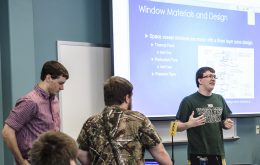Excerpt

Students in an introductory materials science and engineering class analyzed what it would take for humans to safely travel to Mars, live on the red planet and return to earth.
Meteor strikes, temperature extremes, ultraviolet radiation and cramped living quarters – a group of Wright State University engineering students used their collective brainpower to overcome these challenges thrown up by a manned mission to Mars.
“Let’s Go to Mars!” was the final project in the spring semester introductory materials science and engineering class for sophomores taught by Raghavan Srinivasan, professor and director of the materials science and engineering program in the College of Engineering and Computer Science.
“There is a lot of interest in Mars – movies, books and TV specials by National Geographic and the Discovery channels,” said Srinivasan. “It is seen as the first extraterrestrial planet humans will be able to colonize.”
The students were assigned to conduct an engineering analysis of materials that could be needed to go to Mars, live there and return. The 30 students worked in teams on different aspects of the trip, including the spacecraft’s fuel delivery system, exterior shell, windows and heat shield, as well as a Mars ground vehicle and housing on the red planet. They made their presentations in April.
The presentations were well-researched, based on engineering principles and sprinkled with humor. There was a video of a rocket being launched, film clips from the movies “Gravity” and “The Martian” and a homemade video titled “Cooking With Sulfur” to demonstrate how to make Martian concrete for housing.
The fuel delivery system involved an analysis of fuel and oxidizer choices, storage tanks and delivery tubes. Stainless-steel Grade 304N was chosen as the material for the fuel storage tank because it is easily welded, relatively inexpensive to produce and resistant to corrosion. Ultra-high molecular-weight-polyethylene was selected as an outer shielding for the fuel tanks because it is less vulnerable to cracking and resistant to micro-meteor strikes.
Cramped quarters for the six-to-nine-months-long trip to Mars was also a challenge. The students recommended the spacecraft’s frame have a cylindrical shape with a large rotating ring that can provide a gravitational feel for the astronauts. The spacecraft would be assembled in space with Inconel for the high stress areas, and steel and aluminum for lower stress large structural parts. Students also suggested an outer layer of Kevlar to absorb micro-meteor impacts.
For the windows, students suggested a three-panel design with an inert gas between the panes to minimize the chances of the windows rupturing. To overcome atmospheric temperatures, changes in pressure and ultraviolet radiation, the students recommended that the outer pane be fused silica and the inner pane be made of aluminosilicate glass. They also warned that since glasses and ceramics are brittle, precise engineering is essential.
The students suggested that the spacecraft have a blunt-bodied shape to reduce the heat created when plummeting through the Martian atmosphere and a ceramic heat shield because the material has a high melting point and is unlikely to deform. Reinforced carbon-carbon and carbon-ceramic composites are ideal heat-shield materials for re-entering Earth’s atmosphere, the students said. But at $2,600 for a four-by-four-inch sheet one-quarter-inch thick, “You’re not going to find it at Walmart,” one student said. “It’s not going to be a cheap project.”
Housing on Mars must provide sufficient oxygen, the ability to grow food and protection from ultraviolet radiation and temperature extremes. The students suggested using Martian concrete, comprised of 50 percent sulfur and 50 percent Martian soil.
They recommended distributing “organic bombs” around the planet to populate it with oxygen-creating plants. For the short-term, mega greenhouses could be built to grow food using human waste as fertilizer, they said.
Materials for a Mars ground vehicle must be lightweight, stable, vibration-dampening and be made of materials that could withstand extremely cold temperatures without becoming brittle. After comparing alloys of aluminum, iron and titanium, the students suggested a titanium alloy.
“I think they did quite well,” Srinivasan said of his students following their presentations. “A lot of this is beyond material that we cover in class, so they had to do research to figure out exactly what to do. The sulfur concrete – I hadn’t heard of that before.”
The project counted as 20 percent of the students’ grades. Srinivasan will teach the course again this fall semester, but the theme of the final project is yet to be determined. Last fall, the final project topic was fictional vehicles.
Read the entire story at daytondailynews.com

 Milling around
Milling around  Wright State recognizes Nursing Professor Kim Ringo for advancing international student success
Wright State recognizes Nursing Professor Kim Ringo for advancing international student success  Wright State honors graduating students for distinguished doctoral dissertations
Wright State honors graduating students for distinguished doctoral dissertations  Top 10 Newsroom videos of 2025
Top 10 Newsroom videos of 2025  Museum-quality replica of historic Hawthorn Hill donated to Wright State
Museum-quality replica of historic Hawthorn Hill donated to Wright State 